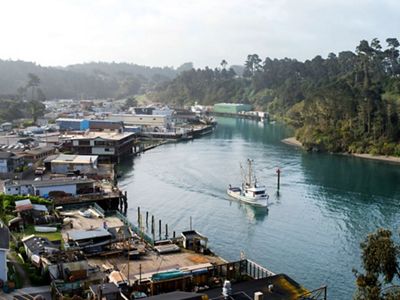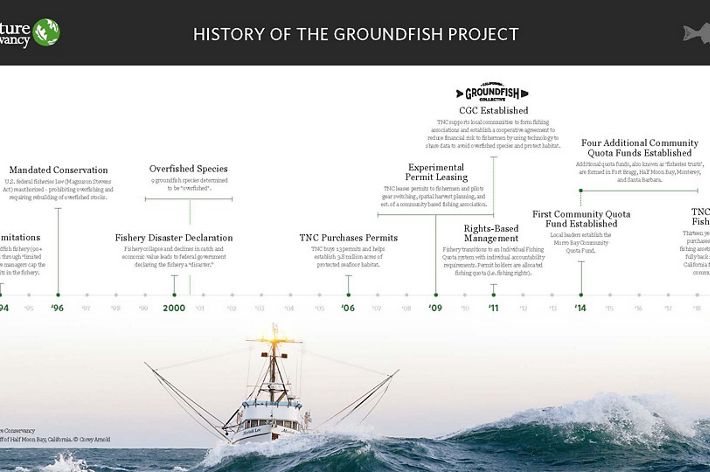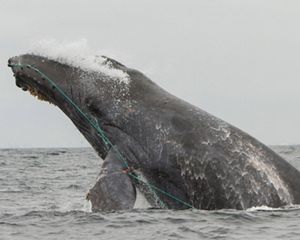California Groundfish Project
Developing economically and environmentally sustainable fishing techniques.
The California Groundfish Project is a groundbreaking collaboration between The Nature Conservancy (TNC) and local fishermen and their communities. Dating back to 2003, the project demonstrates a locally-driven approach to fisheries management.
TNC has worked collaboratively with community leaders and fishermen in California to help revitalize the groundfish fishery that collapsed over a decade and a half ago. Community leaders, fishermen and TNC have found common ground in this effort to achieve healthy ocean ecosystems, productive fisheries, and resilient fishing communities.

The U.S. West Coast Groundfish Fishery: Economic and Environmental Challenge
The West Coast Groundfish fishery off North America includes more than 90 species of finfish in some of the most ecologically productive waters in the world. For decades, fishermen in California’s port communities have harvested species like Petrale sole, Sablefish and rockfishes. Historically, the fishery served as an economic backbone for many port communities, but in the late 1990s, the fishery collapsed due to over-expansion of the fishing fleet and overfishing of some fish populations. This collapse, combined with the regulations that followed, led to a drastic decline in local catch and resulted in lost revenue and jobs.
After the collapse of this fishery, TNC conducted a private buyout of some trawl fishing permits and vessels in 2006. In exchange, fishermen collaborated in the development of a set of no-trawling zones that protected 3.8 million acres of habitat along California’s central coast. Since the trawl buyout, TNC has continued to work with community leaders, fishermen and other partners to advance conservation practices and prevent the loss of community access to the fishery.
From 2008-2011, TNC redeployed the fishing permits acquired in the buyout to help rebuild the fishery and promote the use of new technologies and tools to reduce bycatch and protect important ocean habitat. Fishermen tested alternative non-trawl gears, established spatial fishing agreements, designed and implemented approaches to share catch information, conducted studies on the impacts of trawling, and used the data to better understand local abundance of key groundfish stocks.

Management Structure Changes
In 2011, federal fisheries managers implemented a new type of management structure for groundfish trawl fisheries, known as the Individual Fishing Quota (IFQ) or catch share system. The system divides science-based catch limits into transferable quota shares that individual fishermen can catch annually.
The IFQ system aimed to reduce bycatch of overfished species and improve accountability of fishing activities, but it also presented some challenges. Fishermen were only permitted to catch small amounts of overfished species in order to allow the stocks to rebuild. This had the additional consequence of limiting harvest opportunities for more abundant species because many fish species are caught together, and the overfished species can be difficult to avoid. If a fisherman catches more of a given species than the quota he has been allocated, then his fishing is shut down until he can find more quota. If too many overfished species are caught, the entire fishery can be closed by federal regulators, restricting economic productivity of the community.
With the goal of enhancing the productivity of the fishery while ensuring healthy ocean ecosystems, TNC worked with fishermen to demonstrate the value of voluntary cooperative management in solving these economic and resource challenges under the IFQ system.

A Collaborative Solution: The California Groundfish Collective
TNC is partnering with fishing communities in California to create a voluntary mutual insurance pool of quota—known as a risk pool. The risk pool, called the California Groundfish Collective addresses the overfished species problem by creating a reserve, or pool, of quota. This collective ensures participating fishermen have access to overfished species quota while reducing the risk of catching these species and protecting sensitive habitat.
California Groundfish Collective members collect and share information about where, when and what type of fish are caught using an application called eCatch, an electronic logbook and online mapping system developed by TNC to meet the need for real-time data collection. The Collective uses eCatch to adaptively manage its fishing plans and ensure compliance with the terms of the risk pool. If a fisherman incidentally catches overfished species, the collective quota holdings are used to cover their quota requirements as long as they operated in accordance with the agreed upon terms of the risk pool.
The Collective has demonstrated that adaptive and cooperative management can result in reduced bycatch of overfished species and increased catch of healthy target species compared to the rest of the IFQ fleet. As one indicator of success, the Monterey Bay Aquarium’s Seafood Watch External Assessment Program has rated seafood caught from the Collective with its highest sustainability ranking of “Green/Best Choice.”

Science and Technology
Effective management of fish populations requires the use of timely and high-quality information. This is particularly true in order to be able to respond quickly to climate-driven changes in the ocean. Over the last decade, TNC has worked directly with fishermen, local communities, academia, and management agencies to conduct innovative scientific research, test new approaches, and design tools and applications to improve decision-making.
These innovative approaches include electronic monitoring, a technology which uses video and sensor data in place of human observers on fishing vessels to increase accountability in a cost effective way, and collaborative research, wherein TNC conducts research with fishermen and other partners to fill key data gaps in fisheries management in California.
Policy
By working with government agencies, providing necessary tools, and demonstrating success on the water, TNC can influence governments to adopt reforms at state and national levels. TNC believes that fishermen and fishing communities are the best advocates and the most effective agents of change, and we have worked directly with fishermen to influence fisheries policy and management on the West Coast and nationally.
Today, community leaders that are part of the California Groundfish Collective and the community quota funds have become increasingly engaged in advocating for positive change at the regional and national levels. Fishery stakeholders bring an influential and proactive voice to the policy arena. These partnerships have shown that investing in new models that enhance the roles and responsibilities of fishery stakeholders and community organizations can advance policy reform.

Preserving Community Access to Local and Healthy Fisheries
Maintaining and securing fishing permits or quota in communities can incentivize sustainable practices, preserve fishing infrastructure, help keep a diverse fleet active, provide opportunities for future generations to participate in the fishery, and promote economic stability. Facilitating community ownership of fishing quotas and permits ensures that long term benefits—stemming from a productive and resilient marine ecosystem—are prioritized and accrue to the community rather than just to individuals.
To reduce the potential loss of community fishing rights and promote stability, TNC worked with five communities along the coast of California (Fort Bragg, Half Moon Bay, Monterey, Morro Bay and Santa Barbara) to help develop new, nonprofit community fisheries trusts that would allow for community ownership of fishing rights. These fisheries trusts (also known as ‘quota funds’) protect the sustainability of fishing communities and are governed by boards made up of fishermen, scientists, and local business leaders that determine the best use of fishing rights for long-term community benefit. These organizations can help keep fishing communities economically viable and provide a voice for the community as a stakeholder in the fishery, allowing them to engage in science and management processes.
With the groundfish fishery on the rebound almost two decades after its collapse, TNC transferred the last of its groundfish fishing rights back to fisheries trusts in California in September 2019. This transition passes stewardship responsibilities onto local conservation leaders with the aim of maintaining community access to the fishery, strengthening conservation incentives, and enabling more community participation in the management process. Due to significant rebuilding efforts and over 150,000 square miles of habitat protections in place, many of the groundfish species that were once overfished are rebuilt, allowing for increased catch limits for several species, like canary and bocaccio rockfish, previously star players on restaurant menus before the fishery’s collapse. This is a significant market of success in the bid to bring the West Coast groundfish fishery back to health.

Looking Ahead: a Legacy of Healthy Oceans and Communities in California
TNC’s engagement in the groundfish fishery has driven positive change that can be seen in ports along California’s coast. We are now adapting the lessons learned and approaches developed locally to other fisheries around the world to expand the reach of this reform initiative.
The partnerships established through this project among fishermen, community leaders, managers, and NGOs has broken ground on how collaborative relationships can develop innovative and adaptive solutions to support economically viable and productive fisheries, healthy ocean ecosystems, and resilient fishing communities.
Make a Difference in California
Together, we can achieve transformative change on a scale that’s attainable—for our oceans, for California, and for the world.



